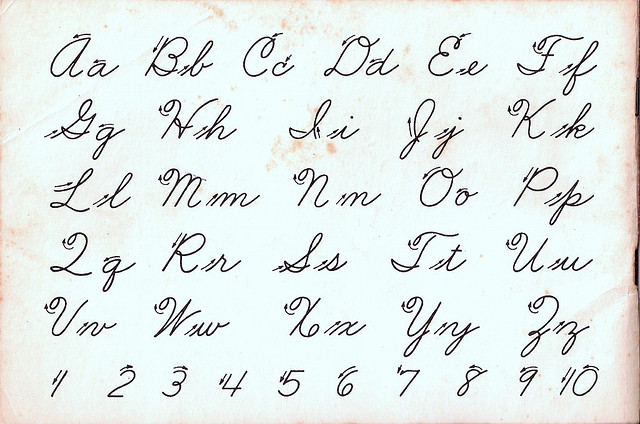Parents often ask me, “What can I do to improve my child’s handwriting?”
I mostly hear this from the parents of elementary school students who ignore appropriate spacing between words, cannot write between the lines, or take an extremely long time to complete any assignment involving writing. Parents express concern about their child’s messy or illegible handwriting and sometimes accuse their kids of not trying because, “when they want to or just take their time they can write neatly.” It is my understanding, however, that many of these children find handwriting to be a source of deep frustration, and their avoidance in doing handwritten work is because it is painfully slow and difficult.
I find that slow and poor handwriting tends to fall into two major categories.
In the first category we find children who simply have messy handwriting. Often, these messy writers have a parent or close relative who is notorious for “writing like a doctor” — nobody can read their writing, either. If this is the case, the child has likely inherited some difficulties with fine or visual motor skills. Many of these children are criticized for their handwriting and find it nearly impossible to write neatly. It is common for these children to struggle in other activities that involve fine motor skills, such as buttoning a shirt or tying their shoelaces. With great effort, they may be able to write legibly, but they need to use so many of their cognitive resources to do so that they may tire quickly or forget what they wanted to write in the first place.
While we can teach these children to modestly improve their ability to write neatly and efficiently, it can be a significant waste of time and resources. Children growing up in the digital world will rarely, if ever, use cursive handwriting in their higher education or vocational lives. Virtually everything that needs to be produced in written form will be done on a screen. It is far better to preemptively teach these children to become excellent typists or masters at speech recognition apps than to expend hours of practice to achieve “readable handwriting.”
 Some of the same fine motor skills that are required for writing fluency and legible handwriting are those that may be used in typing as well. Nonetheless, it is far better to spend the time encouraging these children to learn to type rather than to marginally improve their handwriting. We strongly suggest that typing training start early rather than forcing a child to spend more time learning cursive in their elementary school years. We recommend immediately taking these children (as young as the age of 7) and providing them with the technology and training to become excellent typists. Once struggling writers become competent typists, they may avoid many of the frustrations that they would encounter if they were held to the old standards of handwriting.
Some of the same fine motor skills that are required for writing fluency and legible handwriting are those that may be used in typing as well. Nonetheless, it is far better to spend the time encouraging these children to learn to type rather than to marginally improve their handwriting. We strongly suggest that typing training start early rather than forcing a child to spend more time learning cursive in their elementary school years. We recommend immediately taking these children (as young as the age of 7) and providing them with the technology and training to become excellent typists. Once struggling writers become competent typists, they may avoid many of the frustrations that they would encounter if they were held to the old standards of handwriting.
The key is helping them to become excellent typists who will be able to use these skills to process information quickly, help them to organize their written thoughts, and aid them in overcoming difficulties with working memory that often times become problematic because of the slowness of writing. It would be idyllic if simply becoming a good typist (or learning to master speech recognition software for writing) transformed all frustrated, alienated students into motivated writers. However, this strategy will only work for some students. But there is no risk in trying and the worst that happens is the students become faster typists, texters, and more comfortable with keyboards.
[cjphs_content_placeholder id=”73597″ random=”no” ]
The second group includes those for whom writing is a very slow and arduous process. They may have great ideas but write so slowly that their working memory resources cannot keep their thoughts in mind long enough to get them onto paper. These children can often be identified by their low scores on neuropsychological tests of processing speed and writing fluency. They may need to spend two to three times the amount of time their peers would spend on the same assignment.
For these children, I recommend that rather than teaching typing skills, training in dictation skills may be a superior method for them to express themselves effectively. Many of these children have very good ideas, but it takes them so long to get them onto paper (which may happen even with typing), that they would be better off simply speaking these ideas. Of course learning to dictate effectively is a difficult process and requires far more than simply learning to speak into a microphone. Again, I recommend early training with simple dictation programs that are available on virtually all smartphones and can be a lot of fun for kids to practice with.
Find out more about handwriting and executive dysfunctions by reading our writing skills page. You might also find the first in a planned four-part series, “How Technology Can Help Your Child Become a Better Writer,” to be useful. Then check out our favorite writing websites for kids, free writing apps for iPad, 8 tips for teaching your child to type, our list of typing games & apps, and our Dragon Dictation app review.
For those who are interested more in learning how to use dictation with children, we have written extensively about this and provide training for this for subscribers of LearningWorks for Kids.




